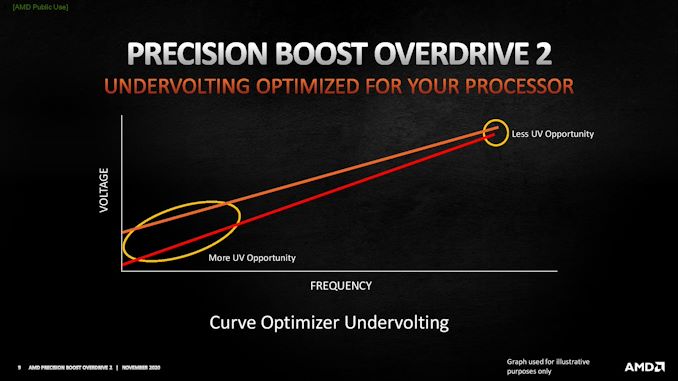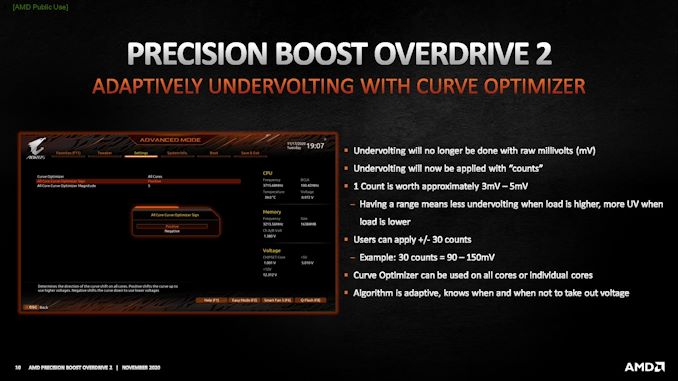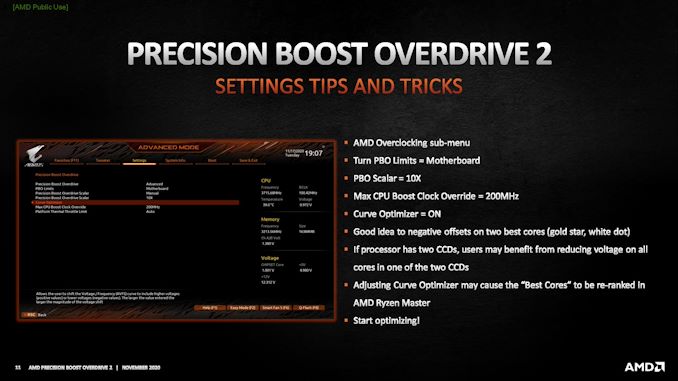AMD Precision Boost Overdrive 2: Adaptive Undervolting For Ryzen 5000 Coming Soon
by Dr. Ian Cutress on November 23, 2020 11:00 AM EST
One of the ways that enthusiasts tinker with their processors is through overclocking: the attempt to get more performance by changing frequencies and voltages, up to the limits of the system. Another way is through undervolting – removing voltage from the processor to help lower temperatures and offer higher thermal headroom (or lower power consumption). It all depends on the silicon, and if it can support it: AMD (and Intel) have to set hard limits for production to enable sufficient yield and costs, but users on certain products can always poke the hardware to try and get something more. With this in mind, AMD is improving its range of overclocking tools to allow for adaptive undervolting of Ryzen 5000 processors.
For any given microprocessor circuit, it requires a minimum voltage to run at a given frequency, before not having enough to complete the process. Most modern processors have a good amount of built-in headroom such that external factors cannot come into play, such as voltage droop based on instantaneous power draw, or as the processor ages, no extra voltage is required. Obviously, a lower voltage means lower power consumption, or more opportunity for higher boost, and so vendors use a variety of techniques to get their processor cores to run as close to the absolute minimum as possible. Despite this, there is always more room to go – vendors have to define a cut-off point between a realistic voltage tracking technique and something that can be scaled for a million processors. Individual users however can skirt those lines for their specific hardware a lot closer than a generic algorithm can.
AMD’s new Curve Optimization tool, to come with AGESA 1180 on 400-series and 500-series motherboard BIOS updates, is designed for this single-user voltage tracking scenario. The goal of the Curve Optimization tool is to opportunistically reduce voltage where possible during low load and high load scenarios, but rather than simply apply a fixed voltage offset across the whole range, it will use other internal sensors (such as workload, temperature, socket limits) to adapt the voltage as required. With AMD’s tool, it should do this on the order of one millisecond, i.e. 1000 times a second.
The Curve Optimization tool will be part of AMD’s Precision Boost Overdrive toolkit, meaning that using it will invalidate the warranty on the hardware, however AMD knows that a number of its user base loves to overclock or undervolt to get the best out of the hardware. The company states that this adaptive methodology will allow for performance gains in both single-thread and multi-thread workloads, as opposed to a standard voltage offset, which they say only really helps with multi-thread examples.
The settings will allow users to test how much adaptive undervolting will be allowed. AMD has tuned the feature such that a user can select how many ‘counts’ or ‘stages’ they want to undervolt by, with each count equating to 3-5 millivolts, up to a maximum of 30 stages. This means that a 10-stage selection will enable a 30-50 millivolt undervolt, depending on the workload and depending on where the control circuitry deems it appropriate.
Performance numbers from AMD would suggest that this technique, compared to a simple fixed undervolt and core frequency increase, can lead to a +2% single thread performance improvement, or up to a +10% multi-thread performance improvement for the Ryzen 9 5900X. AMD stated to us that this technique works best with multiple CCDs, and fewer cores per CCD, so the Ryzen 9 5900X is going to be the best goal for the technology. AMD has also stated that this is going to be applied to all new processors going forward, however it will not be back-ported to Ryzen 3000 as it requires some engineering optimizations in Ryzen 5000 that are non-transferrable.
Users will be able to enable Curve Optimizer through the BIOS initially, with plans to introduce it to AMD’s Ryzen Master software toolkit for Windows sometimes in the new year. Users should note that the best CPU designations inside Ryzen Master may change with these settings, given that the software will see different voltage/frequency curves than at stock. A few motherboards have the feature already present in AGESA 1100 today, however the official rollout will occur with AGESA 1180 firmware updates, initially set to hit the support pages for each motherboard in early December.
Related Reading
- AMD Zen 3 Ryzen Deep Dive Review: 5950X, 5900X, 5800X and 5600X Tested
- AMD to Support Zen 3 and Ryzen 4000 CPUs on B450 and X470 Motherboards
- AMD Clarifies "Best Cores" vs "Preferred Cores" Discrepancies For Ryzen CPUs
- AMD Zen 3: An AnandTech Interview with CTO Mark Papermaster




















59 Comments
View All Comments
Oxford Guy - Monday, November 23, 2020 - link
My 6700K would undervolt to a tremendous degree, just as it would run 3200-rated RAM very high. But, no matter how much stability testing I would do the machine never seemed to stabilize. Prime would run at the low voltage but there would be spurious problems with software. RAM would test with multiple instances of HCL, HCL with Prime, etc. But, again... random spurious problems. So, I went back to defaults.It's a good thing this procedure happens automatically with lots of fast adjustments. I have given up on the coarse (human-derived) approach, both for undervolting and overclocking. I have decided it's simply a waste of time. I have never found true stability with anything but defaults and I have spent a huge amount of time with a variety of systems, almost finding stability but never getting it. As one ages one puts more value in one's time and so it had better be "automagic" for me going forward. Kudos to AMD if this works well.
cyrusfox - Monday, November 23, 2020 - link
I have been amazed by the auto OC on non-K chips achieved with the i7-10700, and a little upset as well as the chip outscores my OC i9-9900KF that is watercooled(Passmark CPU score for the 10700 beats the 9900KF by 8%). All I did on the 10th gen Asrock motherboard was tell it to treat the 10700 as a 135W CPU and it did all the rest(and I did enable XMP as well). I have the 10700 cooled by a Noctua NH-U14S and temps are in the mid 60s when loaded. So the auto OC magic is getting really good from my point of view, when looking between 9th gen intel and 10th gen. Can't speak of AMD side yet but there is less of a reason to individually tweak settings with this kind of magic (and on the Intel side I don't see a reason to get a K part when the non-K already have turbo freq set at the edge/top of the CPU capability.genekellyjr - Monday, November 23, 2020 - link
What you describe is not overclocking in any way, it’s just throttling due to power limits less. It’s not going above its rated boost clocks. Not the same as AMD’s auto-overclock stuff which will go higher than its rated boost clock, and now apparently will also auto-undervolt.Additionally, your i9-9900K only can be slower than an i7-10700 if the i9-9900K is throttling, which is pretty sad for an unlocked processor. It is 100 MHz faster all core and 300 MHz faster single core if it’s not throttling. And it can overclock to past 5 GHz (maybe with an auto-tuning thing in your bios if you didn’t want to much around) - but that’s useless if it’s throttling at stock like it is for you. If you actually wanted auto-overclocking capability an AMD chip would be a much better fit for you, as it does it without any user intervention once enabled (see the AMD 5000 series review here for the 5950X’s 5050 MHz clock)
Dug - Tuesday, November 24, 2020 - link
It does not mean his 9900k is throttling, a 10700 can easily beat a 9900k with differences such as motherboard, memory, etc. and o/c potential.It's also a 65w processor that may have a lot more headroom than you realize, which shows in the passmark score and his own testing which you obviously haven't done.
That being said, it's all going to be within a couple of percentage points overall, so nitpicking his comment doesn't really make any difference, nor does telling him to buy a processor you can't buy right now.
Alexvrb - Thursday, November 26, 2020 - link
I dunno, it does sound like the 9900KF is being held back. Depending on how he's overclocking it, he (or the board) might be getting too frisky with voltage, causing it to bang into thermal limits sooner than a well-tuned OC. "Watercooled" doesn't really mean much either by itself - an NH-U14S with good case cooling can actually beat the snot out of your average CLWCs. Combined with the aforementioned potentially-poorly-tuned voltage and bam, you can't dump the heat fast enough to run at the chip's full potential.Yeah I suppose he could be using much slower RAM, but you'd think he would have thought to mention that. Alternatively he's got some settings buggered up, like he did a BIOS update and forgot to re-enable XMP. A lot of fast RAM kits have really low JEDEC defaults. The motherboard doesn't make a ton of difference as long as they both have good power delivery, and I'm not sure what "etc" factors in to CPU performance. The only other thing I could think of is, did they manage to slip in any additional hardware security mitigations in the refresh?
cyrusfox - Monday, November 30, 2020 - link
The 9900KF of mine is got to be the worst k chip I have ever touched, it is barely stable on an all core 5GHz boost, but I need to set the voltage to 1.4+. XMP is enabled (Which I find helps little in regards to the passmark CPU score) and it is running much faster storage than the other computer (Optane vs SX 8200 pro). Its on a custom water loop with a 2x 480 radiators which also cool a GTX 1080, I assure you a much more capabile solution than the noctua and keeps the temps frigid(although the room heats up...). The mobo is a Z390 M Gaming from Gigabyte. I am planning on replacing it with a 10850k here shortly. I likely jsut got a lemon on the 9900KF and I am wholeheartedly impressed with the non-k chips on comet lake, so much so I would consider a plain old 10900 over the 10850k.Spunjji - Monday, November 23, 2020 - link
I feel pretty much the same on all counts. I've had a number of stable overclocked and/or undervolted systems over the years, but it's become an increasingly rare thing - progressively more squeezing required for less juice. This would be nice, if it can reliably produce a stable system.Arbie - Monday, November 23, 2020 - link
I agree 100%. All the angst over CPU overclocking is (or should be) of concern to very few these days. I'm not going to spend hours of tweaking and testing for a small improvement in full-load performance on a machine that runs at 10% load 99.9% of the time.AMD is offering exactly what I want in this and every other regard. The fact that an Intel chip may "OC better" is laughably irrelevant, and fixating on it only serves to confuse newcomers.
Samus - Tuesday, November 24, 2020 - link
A few years back when I (regrettably) rebuilt my PC around an i7-8700 and an Asus motherboard only because at the time there were no decent ITX solutions for the Ryzen, I noticed insanely bad temps for this 65w CPU compared to the 84w or whatever my previous i7-4770 was. This is a basic closed loop setup in an ITX chassis but it should have handled 65w without a problem.After some digging, this was a common issue on 8th-9th gen Intel CPU's due to BIOSes overvolting by default. My board had the CPU at "initial voltage 1.3v" so naturally it would spike above 80c under load. So I got to playing and had no trouble running 1.15-1.2v (the stock baseline) which effectively resolved all my problems (under 24 hour stress it wouldn't crack 75c.)
Some more playing revealed I could run the CPU even lower. I've had it at 1.1v (some people have reported BSODs this low) for 2 years without an issue and it rarely cracks 70c under load and generally idles around 30c, 3c above room temperature.
I'm not sure why Intel partners are screwing this up so bad.
Alexvrb - Thursday, November 26, 2020 - link
Because Intel allows them to do so even in a default, non-OC-enabled state. Most of the time people are testing desktop performance in a larger chassis or on a bench. Imagine if you are the only motherboard manufacturer that runs at "Intel default" settings, and you are getting consistently murdered in benchmarks all over the internet.It's the reason Intel chips have increasingly run roughshod over TDPs to the point Intel just throws them out the window, even at completely default settings. You can't blame "partners". Intel absolutely could (and should) restrict default behavior, requiring an OC flag to be set to run wild like that. But since they don't, this has even gradually bled over into AMD's strategy. Notice the newer Ryzens, while still better behaved than many of their Intel counterparts, do consume more power at defaults than their "same TDP" previous gen brethren.